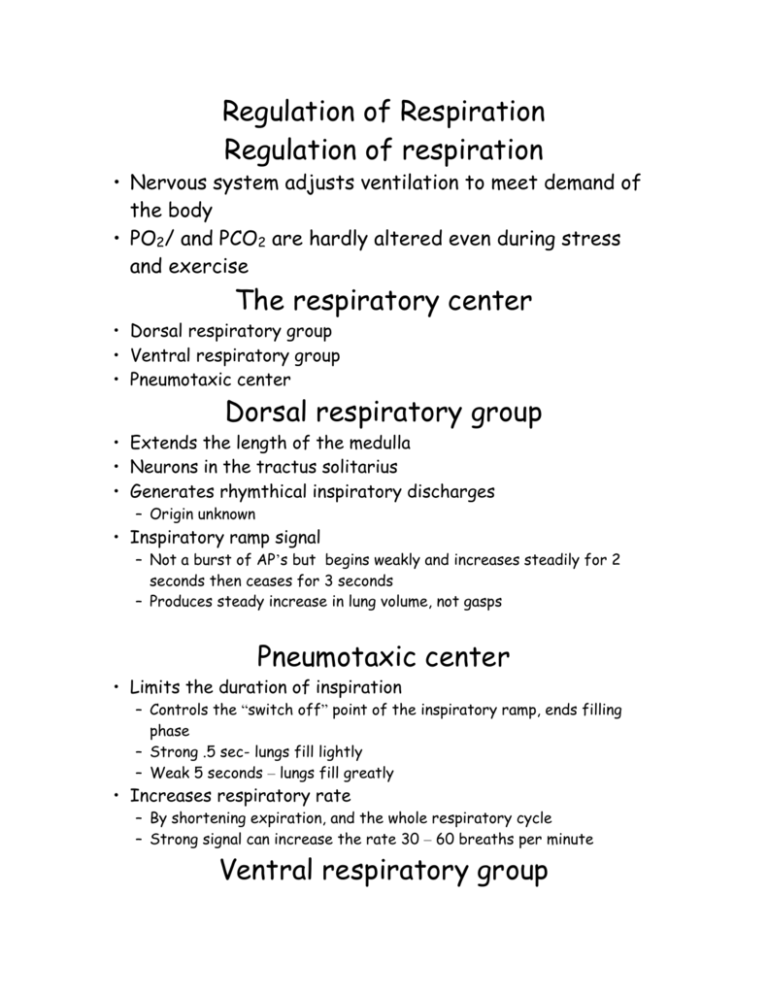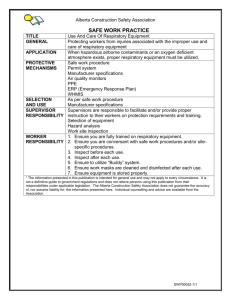Regulation of Respiration
advertisement

Regulation of Respiration Regulation of respiration • Nervous system adjusts ventilation to meet demand of the body • PO2/ and PCO2 are hardly altered even during stress and exercise The respiratory center • Dorsal respiratory group • Ventral respiratory group • Pneumotaxic center Dorsal respiratory group • Extends the length of the medulla • Neurons in the tractus solitarius • Generates rhymthical inspiratory discharges – Origin unknown • Inspiratory ramp signal – Not a burst of AP’s but begins weakly and increases steadily for 2 seconds then ceases for 3 seconds – Produces steady increase in lung volume, not gasps Pneumotaxic center • Limits the duration of inspiration – Controls the “switch off” point of the inspiratory ramp, ends filling phase – Strong .5 sec- lungs fill lightly – Weak 5 seconds – lungs fill greatly • Increases respiratory rate – By shortening expiration, and the whole respiratory cycle – Strong signal can increase the rate 30 – 60 breaths per minute Ventral respiratory group • • • • “overdrive” Functions in both inspiration and expiration Inactive during normal breathing Need increased ventilation – Respiratory signals spill into this center and contribute to respiratory drive • Ventral nerve stimulation causes inspiration • Stimulation of other nerves causes expiration • Provides powerful expiratory signals to abdominal muscles during expiration Ventral respiratory group • Hering-Breuer inflation reflex – Stretch receptors in the bronchi and bronchioles pass impulses through the vagi to the dorsal respiratory group – Lungs over stretch – respiratory ramp switched off • • • • Chemical control over respiration Chemosensitive area of the respiratory center Sensitive to CO2 or H+ Other centers don’t detect them Excites other portions of the respiratory center Chemical control over respiration • Excess CO2 and H+ stimulate the respiratory center • Causes increased strength of inspiration and expiration signals to the respiratory muscles • O2 has no direct effect on the respiratory center Chemical control over respiration • CO2 exerts its effect through conversion to bicarbonate and H+ • CO2 crosses the blood brain barrier (H+ does not) • PCO2 in blood increases, PCO2 in the interstitial fluid increases, PCO2 in the CSF increases • Blood PCO2 has great effect on alveolar ventilation (30-60 mm Hg) Peripheral control over respiratory activity Peripheral chemoreceptors for O2 • Some detect CO2 and H+ • Receptors transmit signals to the respiratory center • – Carotid bodies – Aortic bodies Peripheral control over respiratory activity Role of O2 in Peripheral Respiratory Control • Decreased O2 has no direct effect on respiratory center • Effect is through discharges from the chemoreceptors • Low PO2 stimulates aortic and carotid chemoreceptors, increases respiratory rate, PCO2 goes down and them slows the rate • CO2 and H+ effect chemoreceptors but the effect is minimal compared to their effects in the respiratory center • Fig 29-5 Role of O2 in Peripheral Respiratory Control Exercise and respiratory control • Figure 29-6 Exercise and respiratory control • During exercise – – – – – O2 consumption and CO2 formation increase 20X Alveolar ventilation increases in step with increased metabolism PO2, PCO2 and pH remain normal Brain stimulates the respiratory center along with contracting muscles Prioreceptors transmit excitatory impulses to the respiratory center Pulmonary abnormalities • Chronic pulmonary emphysema – Chronic infection-chronic obstruction-entrapment of air in alveoli- increased airway resistance and decreased diffusing capacity of the lung- • Pneumonia Pulmonary abnormalities – Inflammatory condition of the lung – Alveoli fill with fluid and blood cells – Alveolar membrane is infected with bacteria and becomes porous to fluid and cells • Pneumonia Pulmonary abnormalities • Collapse of alveoli Atelectasis – Airway obstruction – Lack of surfactant Asthma • Spastic contraction of smooth muscle in the bronchioles • Hypersensitivity of bronchioles to substances in the air – IgE attached to mast cells interact with antigen and produce histamine, SRS-A, and eosionphilic chemotactic factor, and bradykinin – Edema, mucus production, and spasms of bronchiolar smooth muscle results





